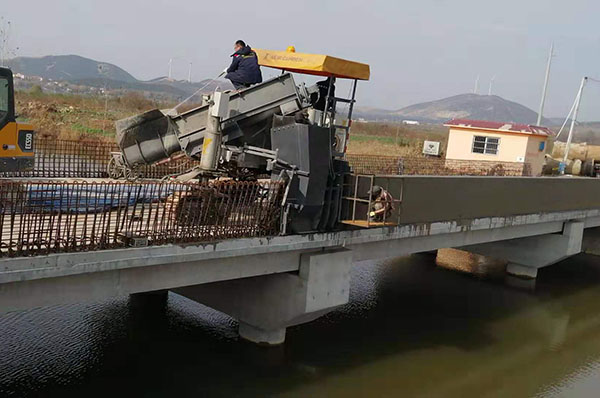In order to realize continuous pavement of bridge deck by curb slipform paver, it is one of the necessary conditions to ensure the construction machinery and equipment that can pave the bridge deck. First of all, the lateral formwork on the kerbstone slip-form paver can meet the requirements of the thickness of the thin reinforced concrete surface layer on the bridge deck, and the continuous steel bars, hanging ring steel bars, steel mesh, expansion joints and expansion joints on the bridge are proofread, which may block the slip of the lateral formwork of the kerbstone slip-form paver. In particular, the blocking and advantage of the transverse complete continuous steel mesh on the bridge deck is that the movable height of the side formwork is only 5cm. Therefore, the side formwork must be a movable lifting type side formwork, which can be lifted to a zero position flush with the extrusion plate. If there is a lengthened side formwork hanging behind the machine, it must also meet the thickness requirements of the paved bridge deck.

The bridge deck pavement of some expressways in our country has been damaged in a very short period of time. One of the most important reasons is that the thickness difference between the longitudinal and transverse pavement layers is too large. The longitudinal pre-stressed reverse arch is too large, some of which are more than 5cm and not less than 3-4 cm after pavement. Transverse in precast reinforced concrete beam, not in the flange plate precast transverse slope, in the beam transverse flange plate between the wet joint, there is a transverse 2-4cm steps, in this case, the beam itself is not balanced in the vertical and horizontal direction, loss of pavement thickness of 2-4cm. From the perspective of construction control, the minimum pavement thickness is 20cm, which is of great value to ensure the quality of actual bridge deck pavement.
During the construction process, the walking position of the planned kerbstone slipform paver for bridge deck pavement should be reserved, especially for central isolated expressways and grade I highway bridges. First of all, the crawler of the two-lane large kerb slipform paver cannot travel in the central isolation and emptying position, nor at the outer edge of the main girder flange plate. Secondly, the bridge engineering should divide the bridge deck paving work into kerbstone slipform pavers for road surface construction. At the same time, the guardrails on the bridge must be made after the kerbstone slipform pavers pave the bridge deck. Otherwise, the bridge railings will block the tracks of the kerbstone slipform pavers and have no paving position.
|
Previous:
No more
Next: No more |
Back to list |